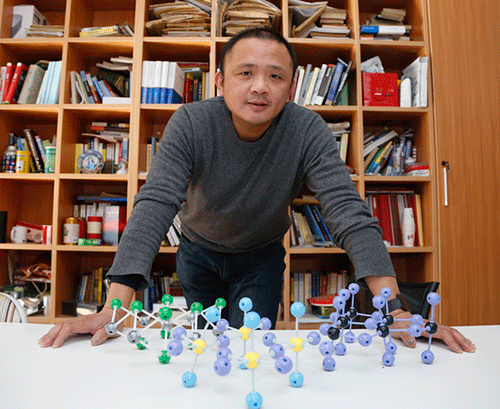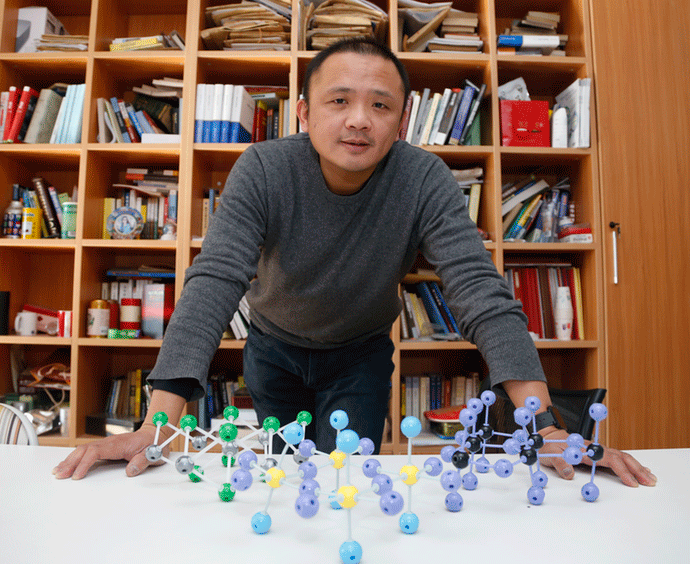Q&A: Uncovering Treasures in Condensed Matter
Xi Dai, a theoretical physicist at the Institute of Physics of the Chinese Academy of Sciences, started his physics career right after the discovery of the first high-temperature superconductor. Infected with “high- fever,” he enrolled in materials sciences and condensed matter physics programs, hoping to contribute to developing a theory for this phenomenon that could guide the search for a room-temperature superconductor. While the high- puzzle is still unsolved, Dai’s theoretical work in related topics put him right at the center of a new condensed matter craze—the physics of topological materials. In 2015, he was part of one of the teams that discovered Weyl semimetals, exotic topological solids in which electronic excitations behave as massless particles known as Weyl fermions. Xi Dai explained to Physics why these materials have him hooked and why condensed matter physics offers untold “hidden treasures” for young researchers to explore.
–Matteo Rini
What are Weyl semimetals?
Weyl semimetals are topological materials with a special electronic state where the spins of electrons are aligned parallel or antiparallel to the direction in which the electrons are moving. In this state, electronic excitations behave like Weyl fermions, massless particles first predicted in 1929. While no evidence for Weyl fermions as fundamental particles has yet emerged, they exist as “quasiparticles” in solids. They have chirality (left or right handed) and a very high mobility. We found experimental evidence for Weyl fermions in certain “arcs” in the bands in which electrons move.
Why does the study of topological materials fascinate you?
I like the power of predicting new phenomena that will then be observed in existing materials or in materials whose design can be guided by our theories. It’s exhilarating to be able to have an immediate and very tangible impact on materials development. We can play with abstract mathematical ideas and then—using state-of-the-art band-structure calculations—explore these ideas in materials. It’s quite different to my early work on high-temperature superconductors where I was mostly refining theories to fit experimental data.
What is the key open problem for Weyl semimetals?
We are still searching for the “perfect” Weyl semimetal—what graphene is for 2D materials. We need a material that keeps its topological Weyl properties at room temperature, is easy to make, and is chemically stable. About 20 Weyl semimetals have been discovered so far, but we still don’t have a perfect one.
What do you think will be the first device to utilize Weyl semimetals?
The field is still at the stage of fundamental research, and we have yet to explore how the unusual properties of these materials could be harvested. The chiral nature of Weyl states may be technologically interesting: under a magnetic field, the imbalance of left-handed and right-handed spins will generate a current, which, in turn, changes the reflectivity of the material at certain wavelengths. My bet is that the first application of a Weyl semimetal will be some kind of sensor that detects magnetic fields through their effect on the material’s optical properties.
Many of the discoveries about topological materials have been made in China. Do you find this surprising?
Not at all. I think this is due to a combination of factors, including healthy funding for research and recent progress in integrating Chinese science into global science and reversing the brain drain towards the US and Europe. But two aspects specifically favor research in topological materials. First, China’s system fosters large-scale collaborations so critical in this field, such as those between crystal growers, theorists, and experimentalists using sophisticated microscopy and spectroscopy techniques. Second, because this field is relatively new, there are few “scientific authorities” in China dictating research directions. Young researchers feel free to test out-of-the-box ideas that can lead to real breakthroughs.
Topological behavior is one of the most complex topics to grasp in physics. Are you trying to engage nonscientists?
I strongly believe that communicating science is among the most important duties of a researcher. At the Institute of Physics, we are exploring many different communication strategies, in particular using social media. We have a public page on WeChat—a Chinese messaging and social networking app with almost a billion users—to engage with nonscientists. There, we post brief summaries of key results of our research. Our WeChat page is ranked in the top five WeChat scientific accounts, an achievement I am really proud of.
Why should students about to embark on their research careers consider condensed matter over any other branch of physics?
Fields like particle physics or cosmology have “beauty at first sight”: big, clear, fundamental questions about our Universe to sink your teeth into. This beauty can be hidden in condensed matter, which, in comparison, can look like an overwhelming, vast sea of different effects, materials, and theories. But look beyond this complexity, and I promise there are plenty of beautiful treasures to discover, many of which could revolutionize our lives.
Know a physicist with a knack for explaining his or her research to others? Write to physics@aps.org. All interviews are edited for brevity and clarity.





